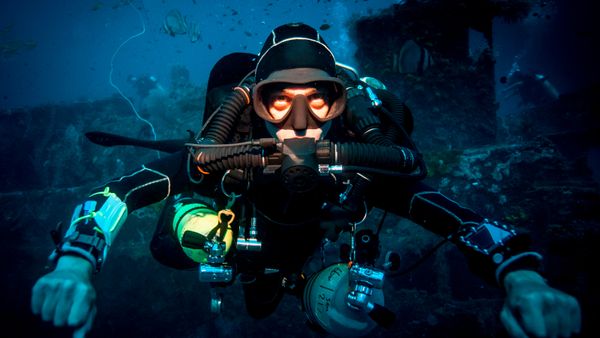
Seriously, how cool would it be to be able to breathe underwater? The possibilities seem endless. We could swim around coral reefs indefinitely. We could play with dolphins without drowning. We could find out what Ringo Starr was trying to tell us with "Octopus's Garden." But as fun as undersea adventures would be, how would having gills affect our day-to-day life?
Surprisingly little. Unfortunately, primates aren't really suited to aquatic living. Our limbs are inefficient for swimming. We don't have enough body hair and subcutaneous fat to spend much time in the water before we are dehydrated and get hypothermia. On top of that, most lakes and rivers aren't clear enough to let us see underwater. Swimming in clear, shallow water in the ocean is fun, but for most inlanders there'd be little to do besides sit on a muddy river bottom hoping an interesting turtle swam by. Even in clear ocean waters, we'd be confined to a few hundred meters below the surface without the protection of a submersible. Oxygen from our gills would keep us from blacking out as we moved deeper, but below 200 meters or so we'd reach the bathyal zone, where it's dark and the water is 59 degrees Fahrenheit or colder [source: Britannica].
Advertisement
Living underwater in the shallows without some pressurized airspace wouldn't be an option either. Because our eyes and ears developed to work in the air, underwater communication would be difficult. Save up a little air in your lungs and you can still talk, but after a while you'd run out of anything that you could use to make your vocal cords vibrate to produce sound. And if you've ever dropped your cell phone in a toilet, you're probably aware that electronics don't work well underwater. Communication would be restricted to hand signals, which again get difficult in murky water. Trying to eat underwater would be the worst part. Have you ever tried to eat a sandwich at the bottom of a lake?
Still, despite all the challenges, being able to live and breathe underwater could change the way we live and build in some interesting ways. For one thing, it would free us from worrying about all the ways that being underwater could kill us. For gilled humans, mining would be a relative cakewalk — no worries about drowning in flooded tunnels — and underwater construction would be cheaper and safer. No one would drown in floods. Venice, Italy, which is currently sinking into the Adriatic Sea, could be stabilized.
And maybe we could incorporate water into our infrastructure. If we could breathe underwater, couldn't we turn our public transportation system into a gigantic waterslide? Instead of buses and trains and roads, we'd have an endlessly cycling system of water tubes. You jump in at one station, whoosh along for a few minutes, and pop out through a side tube a few miles away. Imagine gilled businesspeople in neoprene jumpsuits (stay warm, mammals) hopping in and out of tubes of rushing water, blasting between work and home on half hour-long water slides. That's got to beat riding the subway, right?
Of course, we'd have to get past some significant engineering hurdles. Pumping a massive pressurized water system around a city would take an enormous amount of power, but the biggest problem would be the dirt. Think about how grimy subways and buses can be. In our water tube system, where germs and dirt particles are suspended in water, every trip would be like a sponge bath on the floor of a New York City subway car. Waterborne pathogens would also be a problem (i.e., cholera, typhus). There's a lot to get sick from in untreated water. The water would have to be constantly cleaned, filtered and chlorinated.
That doesn't mean we couldn't have a water-based infrastructure, though — canal systems have potential benefits, especially in coastal cities where they could be cleaned and replenished by the tides. With fashionable neoprene jumpsuits and flippers for everyone, we could comfortably scoot around the city, getting out of the heat in the summertime, reducing the need for air conditioning. We'd become more attuned to water management. We'd pollute less.
And we could completely change the way we farm. As ocean water flowed inland through our canal system, we'd naturally try to find other uses for it, and farming in saline water could be a huge advantage for gilled humans. Currently, there's very little in the way of saltwater agriculture, but channeling saltwater inland would produce a built-in agricultural system to grow salt-tolerant crops. Halophytes — plants such as Salicornia bigelovii that grow in salty soil — absorb freshwater osmotically by making themselves saltier than the surrounding water. They can produce 1.7 times more plants per acre than sunflowers [source: Rozema]. Small ponds interspersed among saltwater crops could be used to raise fish and shrimp, steady protein sources.
Saltwater farming's biggest boon, though, would be the reduced burden on freshwater. Droughts wouldn't affect our ability to produce saltwater crops. In the real world, tremendous amounts of water are used to irrigate land for livestock feed — 1,114 liters for every kilogram of wheat [source: Beckett]. Our proposed saline farmers, however, could grow fodder for livestock without taking up dry land and without depleting the groundwater in dry regions. We'd also be able to grow plants for ecologically friendly but expensive fuels like biodiesel without using the space or water required by conventional food crops.
All in all, being able to breathe underwater probably would have a pretty positive impact on our lifestyle. We'd swim more, eat more fish and be much more careful about how we treat and use water in our daily lives.
Advertisement
